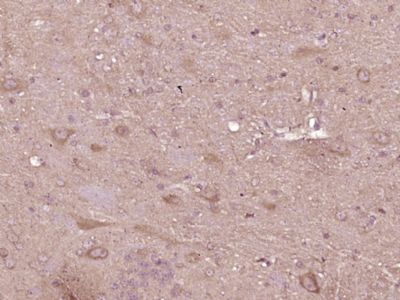COL4A3BP Polyclonal Antibody
Purified Rabbit Polyclonal Antibody (Pab)
- SPECIFICATION
- CITATIONS
- PROTOCOLS
- BACKGROUND

Application
| WB, IHC-P, IHC-F, IF, E |
|---|---|
| Primary Accession | Q9Y5P4 |
| Reactivity | Rat, Bovine |
| Host | Rabbit |
| Clonality | Polyclonal |
| Calculated MW | 71 KDa |
| Physical State | Liquid |
| Immunogen | KLH conjugated synthetic peptide derived from human COL4A3BP |
| Epitope Specificity | 551-624/624 |
| Isotype | IgG |
| Purity | affinity purified by Protein A |
| Buffer | 0.01M TBS (pH7.4) with 1% BSA, 0.02% Proclin300 and 50% Glycerol. |
| SUBCELLULAR LOCATION | Cytoplasm. Golgi apparatus. Endoplasmic reticulum. |
| SIMILARITY | Contains 1 PH domain. Contains 1 START domain. |
| SUBUNIT | Interacts with COL4A3. Interacts with VAPA and VAPB. Interaction with VAPB is less efficient than with VAPA. |
| Post-translational modifications | Phosphorylation on Ser-132 decreases the affinity toward phosphatidylinositol 4-phosphate at Golgi membranes and reduces ceramide transfer activity. Inactivated by hyperphosphorylation of serine residues by CSNK1G2/CK1 that triggers dissociation from the Golgi complex, thus down-regulating ER-to-Golgi transport of ceramide and sphingomyelin synthesis. |
| Important Note | This product as supplied is intended for research use only, not for use in human, therapeutic or diagnostic applications. |
| Background Descriptions | COL4A3BP is a kinase that specifically phosphorylates the N terminal region of the non collagenous domain of the alpha 3 chain of type IV collagen, known as the Goodpasture antigen. Goodpasture disease is the result of an autoimmune response directed at this antigen. One isoform of this protein is also involved in ceramide intracellular transport. Two transcripts exist for this gene. |
| Gene ID | 10087 |
|---|---|
| Other Names | Ceramide transfer protein {ECO:0000303|PubMed:14685229, ECO:0000305}, hCERT, Collagen type IV alpha-3-binding protein, Goodpasture antigen-binding protein, GPBP, START domain-containing protein 11, StARD11, StAR-related lipid transfer protein 11, CERT1 (HGNC:2205) |
| Target/Specificity | Widely expressed. |
| Dilution | WB=1:500-2000,IHC-P=1:100-500,IHC-F=1:100-500,IF=1:100-500,ELISA=1:5000-10000 |
| Format | 0.01M TBS(pH7.4), 0.09% (W/V) sodium azide and 50% Glyce |
| Storage | Store at -20 ℃ for one year. Avoid repeated freeze/thaw cycles. When reconstituted in sterile pH 7.4 0.01M PBS or diluent of antibody the antibody is stable for at least two weeks at 2-4 ℃. |
| Name | CERT1 (HGNC:2205) |
|---|---|
| Function | Shelters ceramides and diacylglycerol lipids inside its START domain and mediates the intracellular trafficking of ceramides and diacylglycerol lipids in a non-vesicular manner. |
| Cellular Location | Cytoplasm. Golgi apparatus. Endoplasmic reticulum Note=Preferentially localized to the Golgi apparatus |
| Tissue Location | Widely expressed. |

Thousands of laboratories across the world have published research that depended on the performance of antibodies from Abcepta to advance their research. Check out links to articles that cite our products in major peer-reviewed journals, organized by research category.
info@abcepta.com, and receive a free "I Love Antibodies" mug.
Provided below are standard protocols that you may find useful for product applications.
If you have used an Abcepta product and would like to share how it has performed, please click on the "Submit Review" button and provide the requested information. Our staff will examine and post your review and contact you if needed.
If you have any additional inquiries please email technical services at tech@abcepta.com.













 Foundational characteristics of cancer include proliferation, angiogenesis, migration, evasion of apoptosis, and cellular immortality. Find key markers for these cellular processes and antibodies to detect them.
Foundational characteristics of cancer include proliferation, angiogenesis, migration, evasion of apoptosis, and cellular immortality. Find key markers for these cellular processes and antibodies to detect them. The SUMOplot™ Analysis Program predicts and scores sumoylation sites in your protein. SUMOylation is a post-translational modification involved in various cellular processes, such as nuclear-cytosolic transport, transcriptional regulation, apoptosis, protein stability, response to stress, and progression through the cell cycle.
The SUMOplot™ Analysis Program predicts and scores sumoylation sites in your protein. SUMOylation is a post-translational modification involved in various cellular processes, such as nuclear-cytosolic transport, transcriptional regulation, apoptosis, protein stability, response to stress, and progression through the cell cycle. The Autophagy Receptor Motif Plotter predicts and scores autophagy receptor binding sites in your protein. Identifying proteins connected to this pathway is critical to understanding the role of autophagy in physiological as well as pathological processes such as development, differentiation, neurodegenerative diseases, stress, infection, and cancer.
The Autophagy Receptor Motif Plotter predicts and scores autophagy receptor binding sites in your protein. Identifying proteins connected to this pathway is critical to understanding the role of autophagy in physiological as well as pathological processes such as development, differentiation, neurodegenerative diseases, stress, infection, and cancer.


